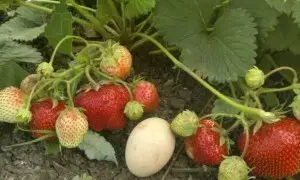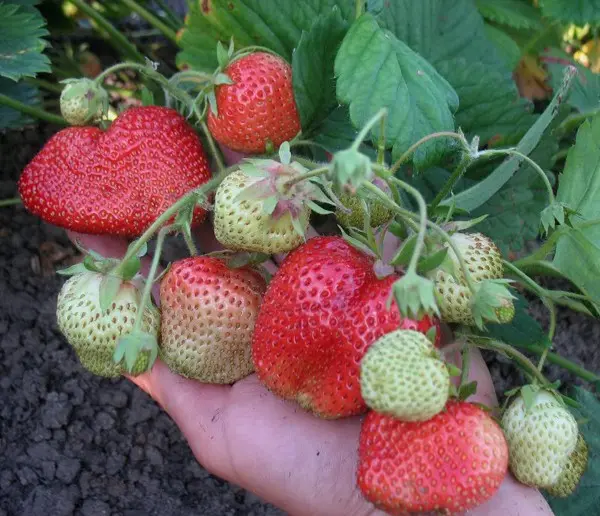Contents
One of the most successful hybrids of Gigantella strawberry Chamora Turusi, although it belongs to the varieties of Japanese breeding, has a mysterious history of origin. Due to its truly grandiose yield and large size of berries, it is becoming increasingly popular among gardeners.
Variety description
Strawberry Chamora Turusi is a high-yielding variety of late ripening. The first harvest can be harvested in the middle and second half of June, mass harvesting starts from June 24-29. The fruiting of the bushes, subject to regular and abundant watering, is quite long. For 2-3 years after planting, the largest yield is observed, up to 2,7-3,2 kg from each bush. In one place, strawberries can bear fruit up to 10-12 years, subject to annual feeding and proper watering, after which the berries become smaller.

Chamora Turusi strawberries have tall, lush, sprawling bushes. In the first years, as a rule, one peduncle is formed with a very large berry later, weighing 140-160 g. After 2-3 years, the number of peduncles increases to 12-16, but the weight of the fruit may decrease slightly – 120-150 g. In subsequent harvests, the berries are somewhat smaller, up to 100-110 g. However, in comparison with ordinary strawberry varieties, they still remain very large.
The fruits are juicy, fleshy, elastic, have a sweet taste with a pronounced strawberry aroma. The core is white, with a main vein, sometimes with a small air cavity near the stem. The content of sugars, vitamins and minerals is high. The berries are round, conical or folded-comb in shape. Depending on growing conditions, weighing up to 70-160 g. Intense red or dark red, with a light top when fully ripe. The bushes are characterized by intensive growth, good survival, they are powerful and sprawling.

Advantages of the variety
A clear advantage of Turusi is its high and long-term yield. Even if the plantation is organized on depleted, heavy soil, the plant still bears fruit well. The berries are very large in size, have excellent taste characteristics, high market value, good transportability and long shelf life; strawberries can be stored in a cool place from several weeks to two months.
This variety is also notable for its good survival rate. Since seedlings always have a well-developed root system, which, when planted in fertile soil, grows very quickly, forming small additional roots that feed the plant. Bushes planted in early spring develop very quickly and intensively and can begin to bear fruit in the first year after planting. Chamora Turusi is resistant to many common fungal diseases. No mite or other pest damage was observed. However, as a preventive measure, chemical treatment should be carried out every spring at the beginning of the flowering period.

Features of agricultural technology
Chamora Turusi belongs to the moisture-loving varieties of strawberries. Since the ripening time of the berries is almost instantaneous, it is 5-7 days, and the fruits are quite large, the bushes require abundant and frequent watering. If during this period the soil is not moistened in sufficient quantity, the berries, without gaining size, begin to ripen. They become lethargic, as when drying, losing their presentation. However, their taste does not deteriorate, on the contrary, they become sweeter with a clear strawberry aroma. As a rule, this is characteristic of the last harvest in mid-late August.
Since the bushes grow very strongly, strawberries are often planted in a two-line method with a distance between rows of 70-85 cm, between rows – 55-60 cm, between bushes – 25-30 cm or loosely in ridges with sides 22-28 cm high, which are organized under cover to shorten the ripening period of the first crop. Be sure to apply organic fertilizers in the form of humus, mullein or chicken manure, wood ash and potassium salts when planting. It should be remembered that the yield depends on the quality of the planting material. It is worth giving preference to rosettes grown from the first bud on the mustache, in peat cups with closed roots. You can not thicken the planting, otherwise the plants may be susceptible to gray rot, and the berries acquire a watery, neutral taste.
The plant is extremely sensitive to moisture deficiency. Therefore, in a dry, hot, summer period, planting is carried out under a canopy, the mulch layer is increased to 4-5 cm and drip irrigation or irrigation of the entire plantation is organized.

Although the plant has a high resistance to fungal diseases, it is advisable to carry out preventive treatment of the plantation with fungicides before and after fruiting. Also, 2-3 sprayings with Aktofit are carried out during the flowering period, when small ovaries appear and at the end of fruiting, when leaves and mustaches are removed. Since this variety has an extended flowering period, the plant can be damaged by strawberry weevil. To avoid this, at the beginning of flowering, the bushes are treated with insecticides, such as DECIS, and again after 4-5 days directly during flowering with Aktofit.
Video “Rules for planting and growing strawberries”
What is the difference between strawberry varieties, how to distinguish strawberries from strawberries, how to choose planting material, what to give preference to, this video tells.









